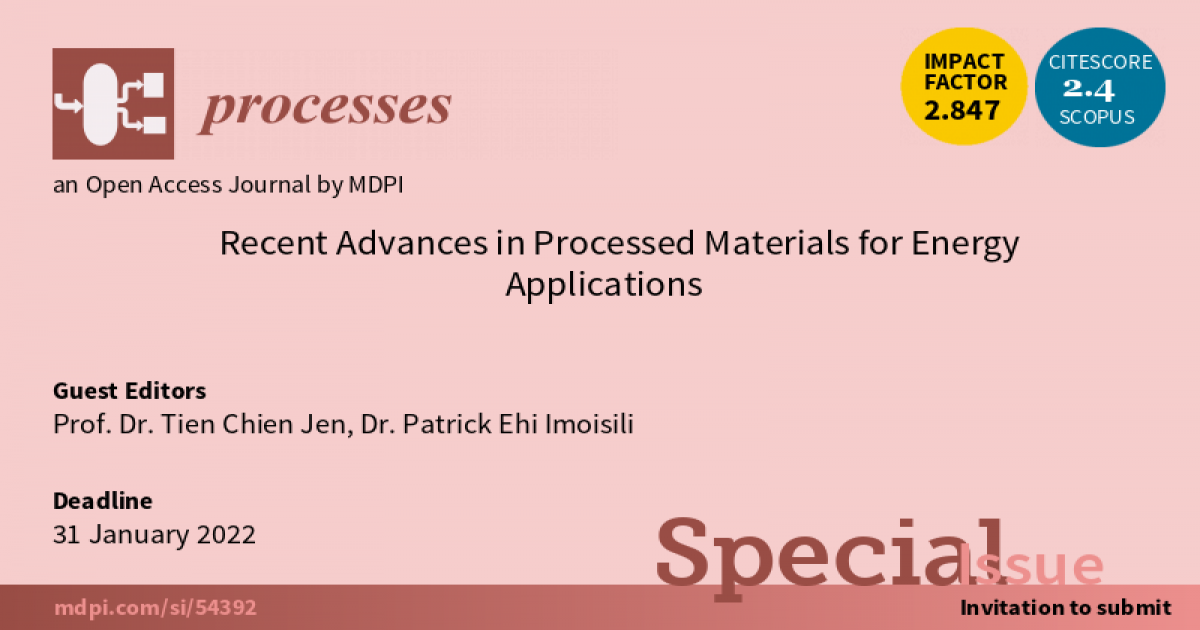Recent Advances in Processed Materials for Energy Applications
A special issue of Processes (ISSN 2227-9717). This special issue belongs to the section "Materials Processes".
Deadline for manuscript submissions: closed (31 January 2022) | Viewed by 19045

Special Issue Editors
Interests: atomic layer deposition; cold gas dynamics spraying deposition; hydrogen generation/filtration/storage; solar cell; fuel cell; nano fabrication; nano structure and materials; renewable energies; bio-fuel
Special Issues, Collections and Topics in MDPI journals
Interests: polymer composites; nanoparticle synthesis; material characterization; thin films; atomic layer deposition (ALD); solar cells; renewable energy
Special Issue Information
Dear Colleagues,
Materials are categorized according to their physical and chemical properties, or their geological or biological source or function. Materials include metals, plastics, wood, glass, ceramics, composites and synthetic fibres. Currently, fundamental materials research is ongoing into the synthesis, characterisation and theoretical understanding of processed materials to be used in energy applications throughout the entire energy landscape. This focuses on research into new and innovative energy-related materials, including alternate vectors for electricity, thermoelectric materials, semiconductors, photovoltaics, semiconductors, fuel cells and materials for energy storage.
Energy storage, an intermediate phase towards the flexible, clean and efficient use of resources, is a global concern and a growing area of research interest. Materials for possible future energy applications include, among others, polymeric, complex oxide, nanoionic, caloric and porous materials. Material fabrication and synthesis for energy applications requires the use of different technologies and methods. These are often methods which produce the appropriate materials which are then processed using advanced processing technologies to obtain specific characteristics suitable for energy applications.
This Special Issue on "Recent Advances in Processed Materials for Energy Applications" aims to inventory the latest achievements in the development and manufacture of contemporary materials used in energy applications. This Special Issue welcomes papers concerning the fabrication, synthesis and design of materials and related technologies, including atomic layer deposition (ALD), composite nanostructured carbon-based materials, semiconductors, photovoltaics, conductive polymers and research on their structural properties, including the testing and characterization of novel materials or the introduction of different types of hybrid materials for future energy technologies.
Prof. Dr. Tien Chien Jen
Dr. Patrick Ehi Imoisili
Guest Editors
Manuscript Submission Information
Manuscripts should be submitted online at www.mdpi.com by registering and logging in to this website. Once you are registered, click here to go to the submission form. Manuscripts can be submitted until the deadline. All submissions that pass pre-check are peer-reviewed. Accepted papers will be published continuously in the journal (as soon as accepted) and will be listed together on the special issue website. Research articles, review articles as well as short communications are invited. For planned papers, a title and short abstract (about 100 words) can be sent to the Editorial Office for announcement on this website.
Submitted manuscripts should not have been published previously, nor be under consideration for publication elsewhere (except conference proceedings papers). All manuscripts are thoroughly refereed through a single-blind peer-review process. A guide for authors and other relevant information for submission of manuscripts is available on the Instructions for Authors page. Processes is an international peer-reviewed open access monthly journal published by MDPI.
Please visit the Instructions for Authors page before submitting a manuscript. The Article Processing Charge (APC) for publication in this open access journal is 2400 CHF (Swiss Francs). Submitted papers should be well formatted and use good English. Authors may use MDPI's English editing service prior to publication or during author revisions.
Keywords
- Materials
- Technology
- Energy
- Characterization
- Structure
- Properties
- Hybrid






